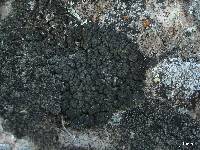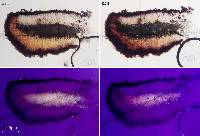
Consortium of Lichen Herbaria
- building a Global Consortium of Bryophytes and Lichens as keystones of cryptobiotic communities -
- Home
- Search
- Images
- Species Checklists
- US States: O-Z >
- US National Parks
- Central America
- South America
- US National Parks
- Southern Subpolar Region
|
Bibbya ruginosa (Tuck.) Kistenich, Timdal, Bendiksby & S.Ekman
 (redirected from: Toninia ruginosa (Tuck.) Herre) (redirected from: Toninia ruginosa (Tuck.) Herre) |
|
|
Family: Ramalinaceae
[Lecidea ruginosa Tuck., moreToninia ruginosa (Tuck.) Herre] |
Nash, T.H., Ryan, B.D., Gries, C., Bungartz, F., (eds.) 2002. Lichen Flora of the Greater Sonoran Desert Region. Vol 1. Life habit: lichenized, lichenicolous or not Thallus: squamulose squamules: up to 5 mm diam., adjacent or sometimes forming a ± continuous crust, rounded or irregularly lobed, weakly convex to bullate upper surface: reddish brown or olivaceous brown to dark brown, epruinose, dull or shiny, smooth or with shallow fissures, lacking pores and pseudocyphellae upper cortex: up to 100 µm high, lacking calcium oxalate margin: concolorous with upper surface Apothecia: up to 1.5 mm diam., remaining ± plane and marginate or plane and marginate when young, later convex and immarginate, epruinose or faintly pruinose; exciple: dark reddish brown in the rim, paler in inner part; hypothecium: pale brown to colorless; epithecium: reddish brown (K+ red, N-) asci: clavate, 8-spored ascospores: narrowly ellipsoid to acicular, 1-7 (9) septate, 12-42 x 3-4.5 µm Pycnidia: laminal, immersed conidia: filiform Spot tests: all negative Secondary metabolites: none detected. Host: cyanolichens Substrate and ecology: on soil and rock in open habitats and woodlands, up to 2470 m World distribution: widely distributed in temperate western North America, rare in western Europe, Greenland, and Tadzhikistan Sonoran distribution: rather common in Arizona, California, Baja California, Baja California Sur and Chihuahua. Notes: Two subspecies were recognized by Timdal (1991), one widely distributed and one restricted to coastal California and Baja California. Intermediate specimens occur in the area of overlap. |
|
|
|
Powered by Symbiota



































































































